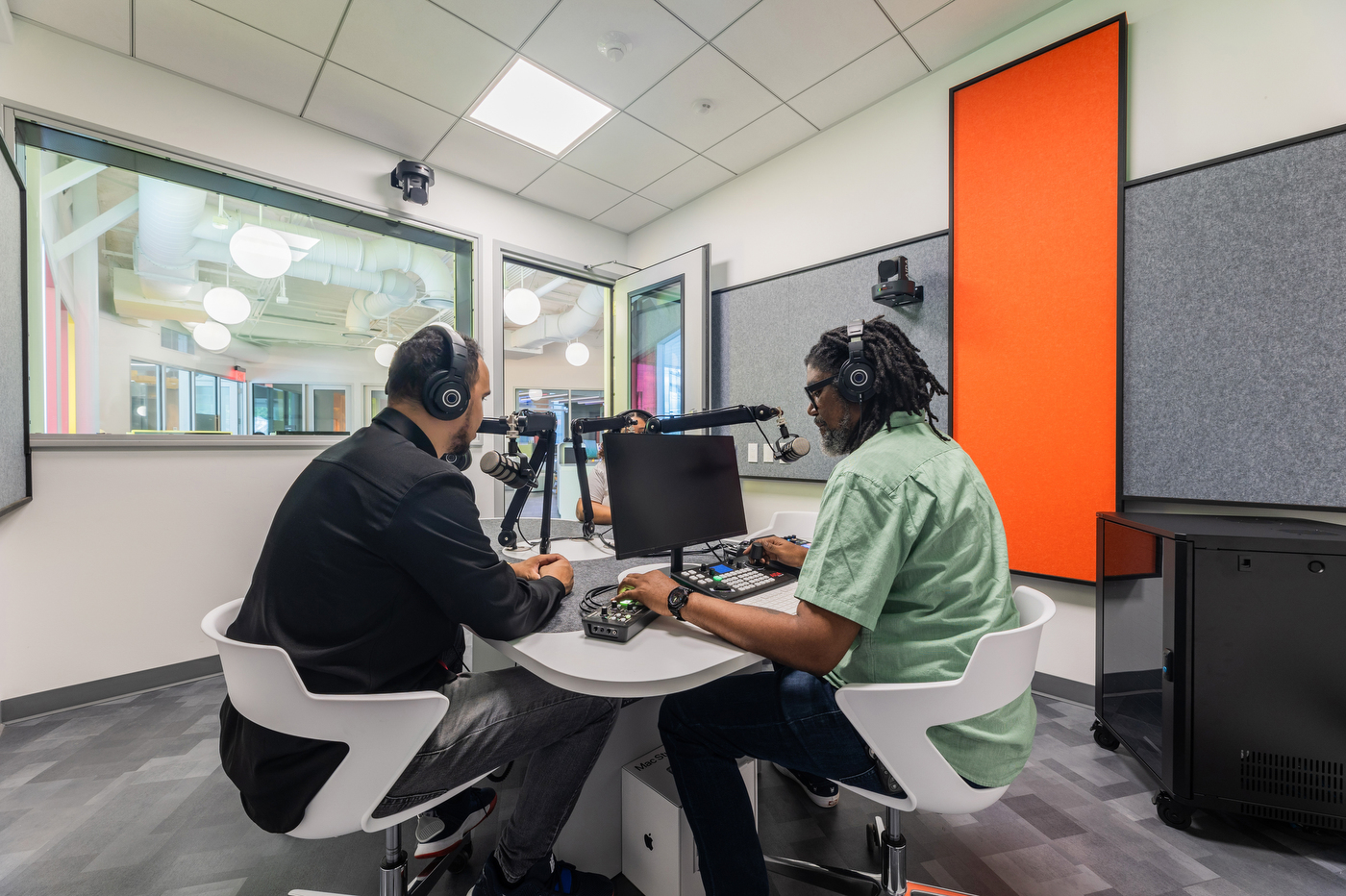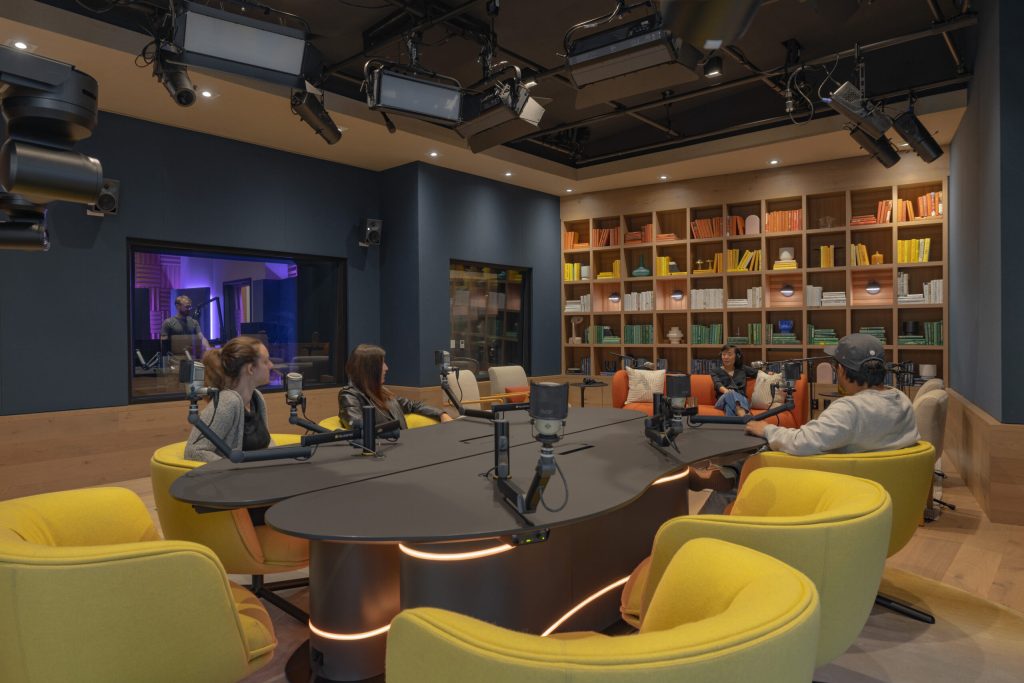The latest edition of “Architizer: The World’s Best Architecture” — a stunning, hardbound book celebrating the most inspiring contemporary architecture from around the globe — is now available. Order your copy today.
Out in the digital ether lies a graveyard of forgotten podcasts. Thousands of episodes launched enthusiastically but quickly faded without ceremony or even a lucrative mattress company sponsorship. Industry insiders call it “podfade.”
Podcasting, when it first began, was a proud DIY medium. All you had to do was grab your iPhone, hit record, and share your thoughts, theories, and queries with the rest of the world. Yet, soon enough, the thing that made podcasting so popular and so accessible, amateurism, became podcasting’s Achilles heel. As podcasts proliferated, listeners grew weary of muffled sound, distracting background noise, and half-hearted productions from noisy coffee shops. They craved something more polished, more professional, and ultimately, more listenable. That meant no more walking and talking, no milk being steamed in the background, and no more cellphone mics. Podcasts have started to be treated like the heyday of radio, and as such, the rise of the dedicated podcast studio has begun.
Architects and designers are being called in to create the perfect podcast studios. Spaces that are not only designed for phenomenal acoustics and precise production but places that provide credibility and inspire creativity in a market fit to burst.
The Wing DUMBO by Alda Ly Architecture (ALA), Brooklyn, New York
The thing is, most podcasts fail to survive. According to industry estimates, over two million podcasts currently exist, with thousands more launching every month. Yet fewer than 20 percent remain active a year after their first episode. Despite this high attrition, podcasting remains big business. Roughly 120 million Americans listen to podcasts monthly, with that number projected to surpass 160 million in 2025. Unsurprisingly, with that scale comes serious commercial potential. Popular shows regularly earn upwards of $50,000 per episode through advertising, sponsorship and syndication deals.
As the medium matures, the line between media brand and podcast becomes increasingly entwined to the point that audio quality, production values and the recording environment all feed directly into listener perception. There’s real science here. Psychology researchers found that high audio quality significantly enhances message credibility and listener engagement. Even something as subtle as the absence of echo reduces listener fatigue and improves message retention. Something that is critical in such a saturated market.
We love podcasts for their intimacy and narrative depth, but audiences today expect a polish that only thoughtful design can deliver. For architects, it starts with sound isolation. You might specify a “room-within-a-room” system, mass-loaded vinyl inside the walls, rubber isolators under a floating floor, and airtight door sweeps to block hallway noise. Equally resilient channels can be used to decouple surfaces so street noise doesn’t sneak into the recording. From there, it’s about reverberation control. Strategically placing absorption panels and baffles or opting for slatted wood that both absorbs and diffuses sound. Strategically placing bass traps in the corners or splaying the walls to eliminate echo patterns also has a huge impact. Even the floor can matter tremendously. A floating subfloor or thick underlayment prevents vibration from traveling up through a mic stand. And it isn’t all about dampening sound. Well-placed reflective surfaces can actually help preserve vocal clarity if balanced correctly. While perforated timber or fabric-wrapped acoustic panels can soak up midrange frequencies without making the space look like a bunker and helping preserve the natural warmth of human speech.
On the tech side, directional mics pick up voices and ignore coughing on the couch, digital mixers let you balance multiple talkers in real-time, and silent ventilation systems keep the air flowing without drowning out the conversation. When these elements all come together — acoustics, materials, technology and even airflow — you get a space that’s both sonically pristine and visually inviting, ready for a polished final product.
However, while acoustic quality may be one challenge for architects and designers who are taking on a podcast studio project, today’s podcasts live as much on screens as they do in earbuds. They’re filmed, edited into short-form clips, and reposted across social platforms, meaning the once-private act of audio recording is now an inherently visual production. As a result, podcast studios need to be choreographed sets that are designed to build credibility, offer intimacy, and project authenticity.
When architecture firm LPA designed a new workplace for Traffik, a global marketing agency in Irvine, California, a podcast studio was high on the list of essentials. Within a busy shopping mall next to brands like Apple and H&M, the glass-enclosed podcast room was deliberately placed to be visible street side. This strategic positioning encourages curiosity from passersby, boosting engagement while communicating the agency’s collaborative ethos. Instead of a conventional recording booth, LPA transformed the space into a highly visible entity in the mall that supports both audio precision and strong brand identity.

Spotify At Mateo Campus by RIOS, Los Angeles, California
The same can be seen at Spotify’s Mateo Campus in Los Angeles, the sprawling 100,000-square-foot facility that unites podcast studios, editing suites, writer’s rooms, and casual gathering spaces within a cohesive, visually rich environment. Instead of traditional recording booths, studios here are more like lounges — spaces layered with soft furnishings, carefully tuned lighting, and a pallet of textures that are distinctly non-corporate. Each detail is intentional, responding directly to the potential for camera presence and ensuring, through choice of space, that every captured image aligns visually with the style of content being made.
Glass partitions, open sightlines, and strategically positioned seating encourage interaction where needed and privacy in other moments. Equally, by allowing glimpses into the recording process, the architecture itself builds on the authenticity required to be successful in this industry. In a crowded market, this openness becomes a strategic advantage by visually suggesting honesty, legitimacy, and trustworthiness to an audience who are wary of media polish and performative perfection.

Dr. Shannon Walker Neighborhood Library by BRAVE/architecture, Houston, Texas
Yet, professionalizing podcast spaces shouldn’t mean losing the medium’s original democratic spirit. In Houston, the Dr. Shannon Walker Neighborhood Library, designed by BRAVE/architecture, incorporated a podcast studio as part of its broader community-focused agenda. The library studio is welcoming yet highly professional, fitted with equipment and acoustical materials usually reserved for private media companies. A community of users utilizes the space — often first-time creators — who feel respected, empowered, and encouraged to share their stories.
This design approach highlights a powerful point: thoughtful architecture doesn’t exclude, it elevates. By providing high-quality recording facilities, community spaces can increase public engagement, attract new demographics to libraries, and amplify the voices of marginalized communities. Truthfully, architecture doesn’t need to be monumental to be meaningful, in instances like this, ensuring professional-quality podcasting is accessible to everyone, spaces become socially transformative. It’s architecture on a human scale — intimate, accessible, and, yes, conversational.
The latest edition of “Architizer: The World’s Best Architecture” — a stunning, hardbound book celebrating the most inspiring contemporary architecture from around the globe — is now available. Order your copy today.


